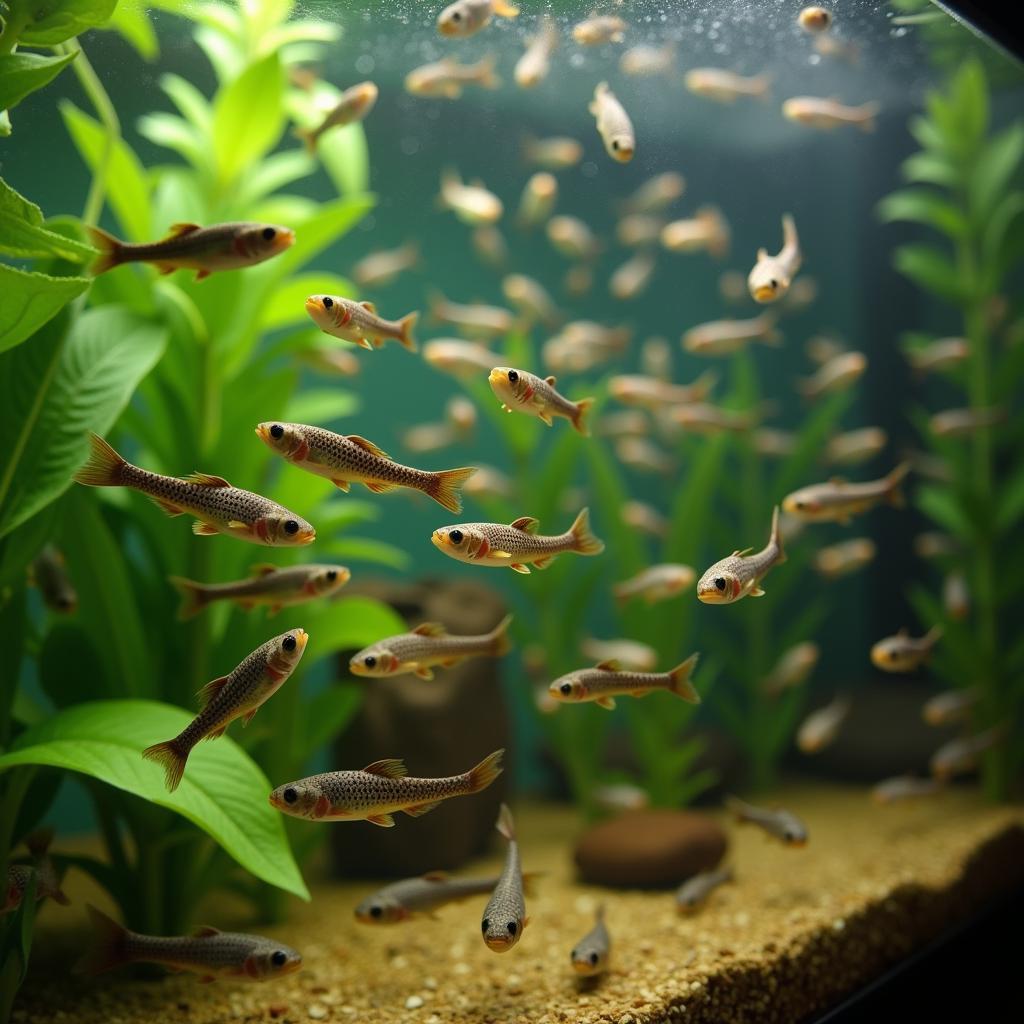A Comprehensive Guide to African Catfish Breeding
African Catfish Breeding is a rapidly growing aquaculture practice offering significant economic potential. This guide delves into the intricacies of raising these resilient fish, from setting up the ideal environment to optimizing growth and managing potential challenges. Whether you’re a seasoned fish farmer or just starting, this resource will equip you with the knowledge you need to succeed in African catfish breeding. Let’s explore the world of these fascinating creatures and the art of cultivating them.
Understanding the African Catfish
African catfish, scientifically known as Clarias gariepinus, are renowned for their hardiness, rapid growth, and adaptability to various environments. These qualities make them ideal for aquaculture. They thrive in warm, freshwater environments and are tolerant of a wide range of water conditions. Understanding their natural habitat and behavior is crucial for successful African catfish breeding. They are omnivorous, meaning their diet can include a variety of protein sources, from insects to pellets. This flexibility simplifies feeding regimes and contributes to their cost-effectiveness in farming. Furthermore, their high fecundity, or ability to produce a large number of offspring, makes them particularly attractive for commercial production. Mastering these fundamental aspects of their biology sets the stage for a prosperous breeding venture.
Setting up Your Breeding System for African Catfish Breeding
A well-designed system is essential for successful African catfish breeding. You can choose from several methods, including ponds, tanks, and concrete raceways. Ponds offer a natural environment but require careful management of water quality. Tanks provide greater control over environmental parameters but can be more expensive to set up. Concrete raceways offer a good balance between cost and control. Choosing the right system depends on your budget, available space, and production goals.
For example, a small-scale operation might benefit from using tanks, allowing for close monitoring of individual fish. Larger commercial farms often opt for ponds due to their lower cost and ability to accommodate higher fish densities. However, regardless of the chosen system, maintaining optimal water parameters, including temperature, pH, and dissolved oxygen, is critical for healthy fish growth and breeding success.
Breeding and Hatchery Management
The breeding process begins with selecting healthy, mature broodstock. Inducing spawning through hormonal injections is a common practice in African catfish breeding. After spawning, the eggs are collected and transferred to hatching tanks. [african catfish hatchery] can be a valuable resource for this critical stage. Maintaining appropriate water temperature and oxygen levels is crucial for successful hatching.
Once the fry hatch, they require specialized care and feeding. Providing a diet rich in protein, such as zooplankton or commercially available fry feed, is essential for their rapid growth. Regularly monitoring water quality and removing any dead fry helps prevent disease outbreaks. Proper hatchery management sets the foundation for healthy fingerlings and ultimately contributes to the overall success of your African catfish breeding operation.
 African catfish fry in a tank
African catfish fry in a tank
Growing and Harvesting
Once the fry reach the fingerling stage, they can be transferred to grow-out systems. Providing a balanced diet and maintaining optimal water quality are crucial for maximizing growth rates. Regular monitoring of fish size and health is important for identifying any potential problems early on. [african freshwater fish species] often require similar water conditions, allowing for polyculture opportunities, which can increase the overall productivity of your system. You can also find helpful information about related species, such as [african chiclids], to broaden your knowledge of aquaculture. Videos demonstrating effective techniques, like an [african cat fish breeding video], can offer practical insights and enhance your understanding of the process.
Harvesting typically occurs when the fish reach market size, which can vary depending on local demand. Proper harvesting techniques minimize stress on the fish and ensure product quality. Understanding the local market and consumer preferences will help you determine the optimal harvesting time and maximize your profits. If you’re interested in exploring different types of African catfish, you might want to learn more about the [african mushi fish in kerala].
Conclusion
African catfish breeding offers a promising opportunity for both small-scale and commercial aquaculture. By understanding the key aspects of their biology, setting up a suitable breeding system, and implementing proper management practices, you can achieve success in this rewarding venture. Remember to continually adapt your techniques based on your specific environment and market demands to maximize your yield and profitability with African catfish breeding.
FAQ
- What is the ideal water temperature for African catfish breeding? (Answer: 28-30°C)
- How often should I feed my African catfish? (Answer: Twice daily is recommended for optimal growth.)
- What are the common diseases affecting African catfish? (Answer: Bacterial infections, parasitic infestations, and fungal diseases.)
- How can I improve water quality in my catfish ponds? (Answer: Regular water changes, aeration, and the use of probiotics.)
- What is the typical growth rate of African catfish? (Answer: They can reach market size within 6-8 months.)
- What are the main challenges in African catfish breeding? (Answer: Maintaining water quality and preventing disease outbreaks.)
- How can I maximize the profitability of my catfish farm? (Answer: Optimize feeding strategies, improve growth rates, and target the right market.)
Situations and Common Questions
- Scenario: You notice your catfish are not eating as much as usual and some are swimming erratically. Question: What could be wrong with my catfish?
- Scenario: Your catfish fry are not surviving the hatching stage. Question: What are the common causes of fry mortality?
- Scenario: Your pond water is becoming cloudy and smells foul. Question: How can I improve the water quality in my pond?
Further Exploration
For more information, explore other related articles on our website.
Contact Us
For assistance with African catfish breeding, contact us: Phone: +255768904061, Email: kaka.mag@gmail.com or visit us at Mbarali DC Mawindi, Kangaga, Tanzania. Our customer service team is available 24/7.


